The Chinese New Year holiday is set to officially begin on January 24! If you’re looking to escape the city for a little well-deserved R&R, then this guide to nearby holiday getaways is for you!
1. Kaiping Diaolou and Villages
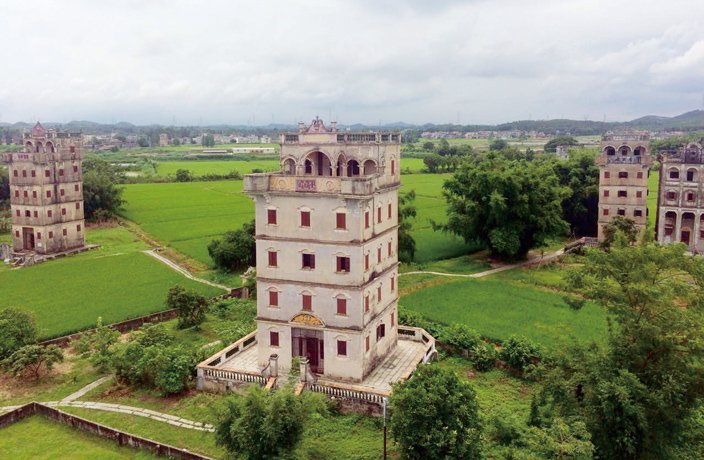
Image by Matt Bossons/That’s
Located 130 kilometers southwest of Guangzhou, the Kaiping Diaolou and Villages are presently the only UNESCO World Heritage Cultural Site in Guangdong province.
The diaolou – fortified, multi-story residences made of concrete – came into being as a remedy to several societal ills. Kaiping was in times past the victim of floods, rampant banditry and the devastating Punti-Hakka Clan Wars (an enduring conflict occurring at the end of Qing Dynasty between the Cantonese-speaking natives and the migrant Hakka people that resulted in hundreds of thousands of deaths).
Combating these issues, diaolou served as watchtowers, shelters from flood and blockhouses against raiders.
The diaolou are one-of-a-kind structures, dispersed among paddy fields and flaunting a melange of Chinese, Western and, in some cases, Islamic architecture. From their exteriors you can detect Roman domes, Greek porticos and Gothic windows, while most of the interior design retains southern Chinese flair.
As scattered as they are, there are four major clusters of watchtowers: Zili, Jinjiangli, Sanmenli and Jianglong.
How to get there:
Take the coach from Guangzhou Railway Bus Terminal or Tianhe Coach Terminal to Kaiping (RMB70), then take a local bus to one of the diaolou clusters (remember to tell the bus driver your destination). Tickets to the villages range from RMB50-80.
Recommended accommodation:
Diaomin Buluo Boutique Guesthouse (碉民部落精品民宿) is a newly opened branch of Diaomin Buluo Inn, a popular hostel situated along the river’s edge in 400-year-old Chikan town, which is currently under renovation. The boutique guesthouse, located about 2 kilometers from Zili village, is a highly recommended accommodation for budget travelers. There is a total of 14 rooms catering to solo travelers, couples and families. The guesthouse also boasts a small cafe and bar, which serves basic Western meals (with a typical Chinese twist) and booze. For reservations, call 0750-261 6229.
2. Shaoshan, the Childhood Abode of Mao Zedong

Image by Tom Lee/That’s
For anybody interested in Mao and the history of communism in China, a visit to old Shaoshan is informative and eye-opening – not least because it provides a window into how the PRC wants people to perceive its founder.
Old Shaoshan is a pretty little hamlet with Mao’s childhood home at its heart. This bungalow, made from earth and wood, is easily identified by the long queue of people stretching back from its doors, waiting patiently to trudge through the bare rooms that once enclosed the communist hero.
Millions flock here every year to see where the Great Helmsman spent his early life. Most of these visitors are Chinese, though the surprisingly accurate English, French and Russian translations that greet visitors at the vehicle drop-off point attest to the government initiatives afoot to encourage foreign travelers.
If you stay the evening, you can also get tickets to a grand production that celebrates Mao’s life several times an evening, or visit a local restaurant to gorge on Mao’s favorite food: hongshao rou (braised pork in sauce).
How to get there:
High-speed trains go from Guangzhou South and Shenzhen North to Shaoshan South Station (RMB345-1,90). From there, tell anybody you see that you want to go to 毛泽东同志纪念馆 (Mao Zedong Tongzhi Jinian Guan) and they will direct you to the correct local bus or shuttle.
Recommended accommodation:
Ideally located within walking distance of Mao Zedong’s former home and Statue Square, the Hualong Hotel Shaoshan offers comfortable, clean rooms at prices that generally fall below RMB500 (although that may not be the case during holidays). The hotel is a good option for a weekend getaway due to its close proximity to tourist sites and scenic areas, as well ‘downtown’ Shaoshan and the train station.
3. Conghua Hot Springs Town
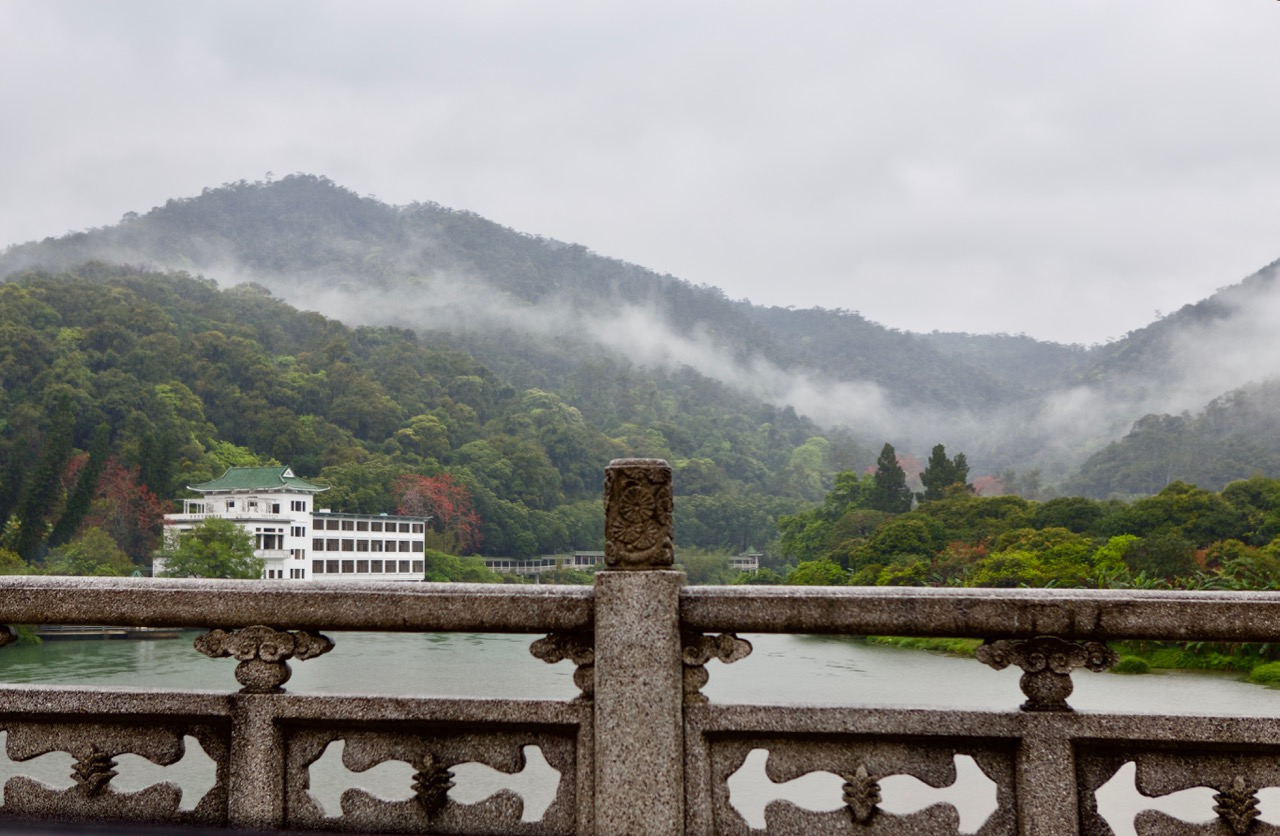
Image via That’s
No weekend getaway quite compares to the relaxation derived from bathing in a natural hot spring, and Conghua Hot Spring Town even saw former US President Richard Nixon himself visit for a bit of steamy R&R in 1976.
Literally called ‘Hot Springs Town’ or ‘Wenquan Zhen,’ it is located in the northern part of Conghua, which is now a district of Guangzhou’s ever-expanding megalopolis. There’s absolutely nothing to do in Hot Springs Town except, you guessed it, lounge in revitalizing mineral water, so hibernating in your hotel room all weekend won’t bring pangs of guilt.
How to get there:
Take Guangzhou Metro Line 14 and ride to the last stop, Dongfeng Metro Station. Take a 30-minute cab to Guangdong Hot Spring Hotel (广东温泉宾馆). From there, you can easily walk to other hot spring resorts.
Recommended accommodation:
Dozens of resorts compete along the river, but the one at the very end of the road – Guangdong Hot Spring Hotel – has our vote as the oldest and most scenic lodge that housed not only Nixon but Mao Zedong, Zhou Enlai, Deng Xiaoping, Jiang Zemin and countless other heads of state back in the day.
You can book the suite where they stayed for about USD5,000 a night, or opt for a room with a private patio spa that seats four to six for around RMB1,000. Simpler rooms (RMB300) still let you fill your indoor bathtub with hot spring water, but if you want to squeeze in more than one person at a time you’ll have to venture outside to the public pools.
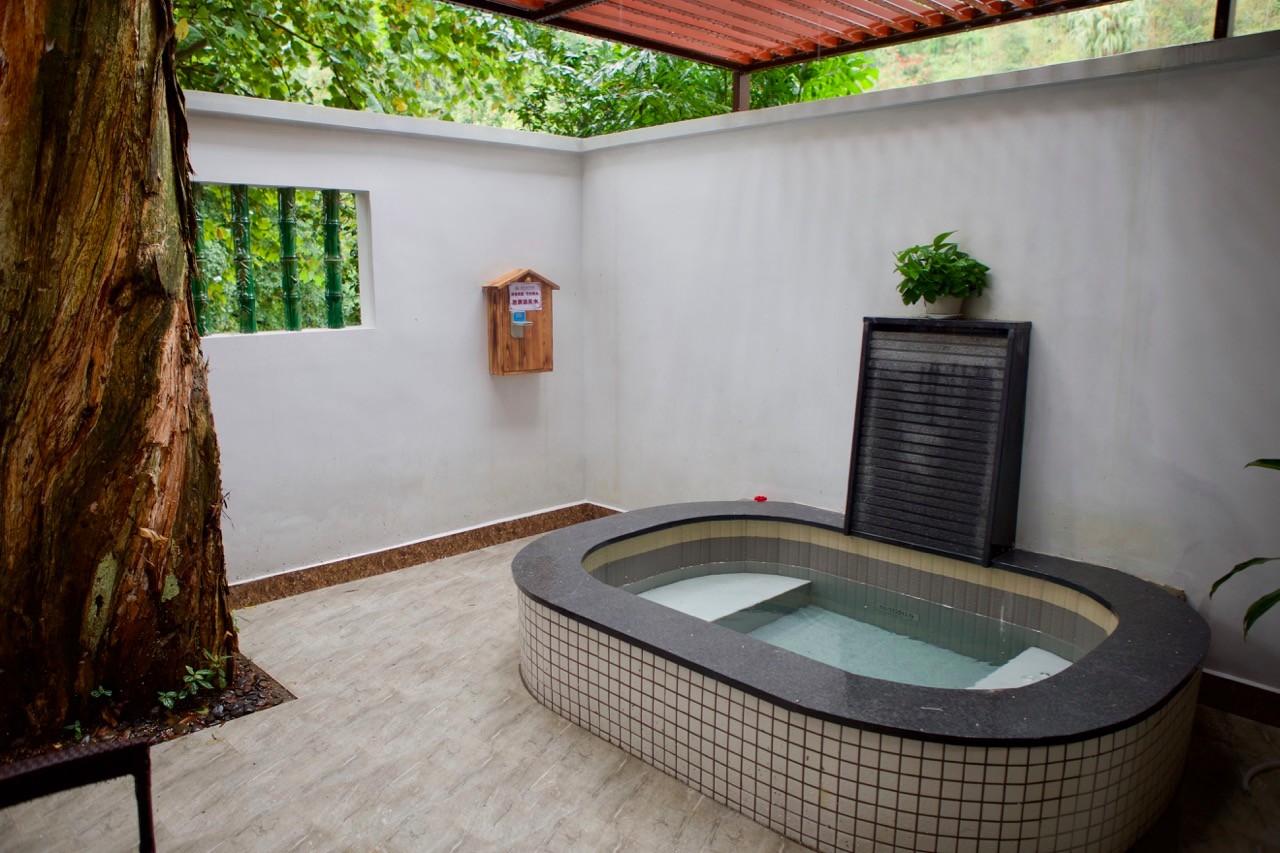
Image via That’s
Aside from a few historic plaques and two lengthy outdoor corridors that were clearly intended for leaders to pace back and forth while mulling over world problems, there’s nothing political about the hotel, which, although built in 1955, is still refreshingly well-designed by China standards.
4. Lamma Island
Image via That’s
One of Hong Kong’s smaller surrounding islands, Lamma Island is probably the closest you can get to vacation mood without dropping the big bucks on a plane ticket. It also sports one of the cleanest beaches in Hong Kong and affordable vacation rental prices – quite unusual for the pricey former British colony.
Yung Shue Wan is the very heart of Lamma Island. A small village mixing restaurants, residential properties and small shops in a bright, delightful mosaic, hotels and smaller private properties are abundant – and the deals get better as you venture further away from touristy spots.
The island is full of Mediterranean flavors – and not just in the abundant fresh seafood. Sea views, quaint little houses, cozy sandy beaches and a laid-back pace are all the right ingredients for a complete recharge.
Lamma is also one of those rare places where the journey is actually quite a pleasant process in itself. Think about it: a half an hour ferry from Hong Kong is way more relaxing than a bumpy ride on a cramped bus. You can spend the commute admiring the calming sea paysage or creating some artful photos for your Instagram report – whichever strikes your fancy.
How to get there:
Once in Hong Kong, take either metro or bus to Central. Lamma is served by ferries from Central Pier 4 on Hong Kong Island and from Aberdeen on the south side of Hong Kong Island. There are separate services to both of the main villages on the island, Yung Shue Wan and Sok Kwu Wan. The journey time is 27 minutes to Yung Shue Wan and 30-40 minutes to Sok Kwu Wan. Vessels are monohull and some of the boats have a small outside canopy-covered area at the rear of the upper deck.
Recommended accommodation:
Possibly most notable on the island for both value and comfort is the Concerto Inn. This quiet beachside hotel comes with rooms equipped with AC, a flat-screen TV and a mini bar. Select rooms also boast a balcony.
Located a 20-minute walk from the Lamma Island pier, Concerto Inn has an outdoor area for barbecues and parties, as well as a restaurant that offers a la carte breakfast and a must-try hamburger.
5. Qingyuan
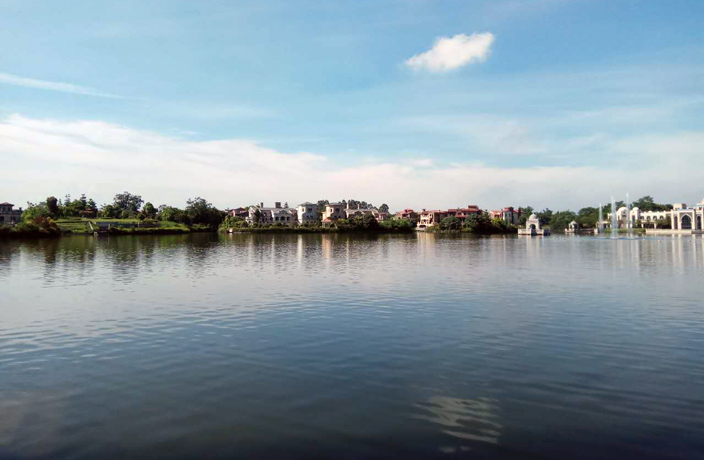
Image via That’s
Located a short train ride from Guangzhou, Qingyuan is undoubtedly one of our favorite weekend getaways. Guangdong’s largest prefecture by land area, the region boasts scenic mountains, forests, rivers and lakes, offering no shortage of outdoor activities, from hiking, rafting and fishing to rock climbing and cave exploration.
The area is perhaps most famous for its relaxing natural hot springs, which, we can attest from experience, are spectacular.
If drinking a cold pint in hot mineral water isn’t really your thing, then maybe a walk along Qingyuan’s 60-meter-long glass bridge is what you’re looking for. The custom-made glass walkway is almost 100 meters above the ground and travels between Qingyuan’s karst caves.
For GBA-based foodies, a trip here is essential to sample the area’s renowned ‘Qingyuan chicken,’ locally farmed, free-range birds that are said to offer a superior taste to those raised in Guangzhou.
How to get there:
High-speed trains go from Guangzhou South and take approximately 20 minutes, while trains to Qingyuan from Guangzhou Railway Station, in Yuexiu, take roughly 45 minutes.
Recommended accommodation:
Sheraton Qingyuan Lion Lake Resort is in itself a destination, boasting beautiful Arabian-style decor, lake views, three restaurants, both indoor and outdoor pools, a fitness center and tennis court and access to the Lion Lake Golf Club.
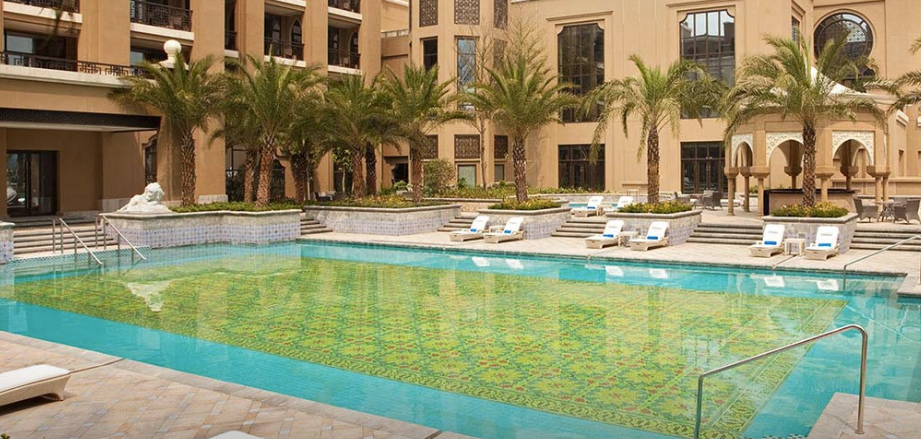
Image via Sheraton Qingyuan Lion Lake Resort
While the resort’s Italian restaurant, Bene Italian Kitchen, and buffet eatery, Feast Signature Restaurant, both offer great variety, quality and value, Yue Chinese Restaurant is a must visit. Yue focuses on traditional Cantonese edibles that date back to the 1960s, as well as contemporary Chinese fusion dishes, and the Qingyuan chicken is a must-try.
6. Nansha Wetland Park and Tin Hau Palace

Image by Matt Bossons/That’s
Chosen as one of the ‘Eight Sights of Guangzhou’ in 2011, Nansha Wetland Park is located about a two-hour transit journey from the city center – although the commute does have its rewards. At Nansha Wetland Park, the chaotic sounds of the city are replaced with a symphony of bird calls and, on our visit, the rustling of leaves in the autumn wind.
Of China’s 271 wetland bird species, 140 of them can be found in this man-made eco-destination, depending on the season (many of the birds in the park are migratory), including the oriental white stork – a first-class national protected species. According to one of the many bilingual signs that dot the Nansha Wetland Park, up to 100,000 migratory birds spend the winter in the park each year.
Visitors must pay RMB40 to enter and have three main options for exploring: on foot, via shared-bike or by boat. The latter option offers curious daytrippers a unique view of the park’s numerous waterways, albeit for the kinda-steep price of RMB100.
Also in Nansha District: the Tin Hau Palace. While downtown Guangzhou certainly doesn’t boast any temples or buildings that can compete with Beijing’s Summer Palace, in outlying Nansha District there is a similar-style attraction that demands a visit from those living in, or visiting, the PRD.

Image via That’s
Staring proudly upon the Lingding Ocean, at the mouth of the Pearl River, the Nansha Tin Hau Palace boasts a 50-foot-tall statue of Mazu, a deity often referred to as ‘Goddess of the Sea,’ and panoramic views that are a welcome respite from skyscrapers and office blocks.
Originally built in the Ming Dynasty, the structure was renovated during the reign of Emperor Qianlong, in the Qing Dynasty, but was later ruined, leading to a 1994 restoration that was completed in 1996.
How to get to Nansha Wetland Park:
Take Guangzhou Metro Line 4 to Jiaomen Station and then catch the 南g1 bus, which you will ride for one hour and 20 minutes (five stops) to Shijiuchong, right outside of Nansha Wetland Park.
How to get to Nansha Tin Hau Palace:
Take Guangzhou Metro Line 4 to Jinzhou Station and then take Nansha bus No. 4 to the east gate of Tin Hau Palace. Alternatively, hop on the back of a moto-scooter at Jinzhou Station and ride to the temple in style! (Cost for a scooter from the metro to the temple should average around RMB20).
Recommended accommodation:
If venturing by bus around Nansha sounds like a tiring endeavor, you may want to consider spending the night. We can recommend the Sheraton Guangzhou Nansha Hotel, which is located a 15-minute walk from Guangzhou Metro Line 4’s Jinzhou Station and boasts a fantastic Chinese restaurant, Yue, honored as ‘Outstanding New Chinese Restaurant’ in our 2017 That’s Food & Drink Awards in Guangzhou.
7. Tai O, the Village on Stilts
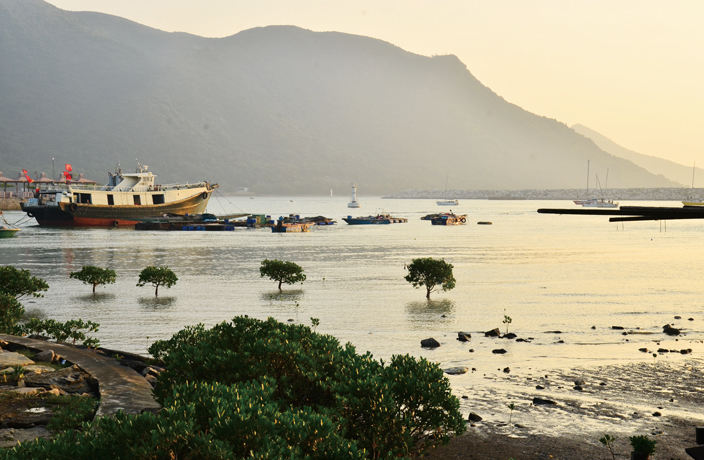
Image via That’s
If you’re up for doing something different in Hong Kong that involves going a bit further out of the city center and spending a bit less, here’s a side of the city you haven’t met before: natural, pristine and, most surprisingly, slow-paced.
Tai O is a small fishing village on the island of Lantau, right next to Hong Kong International Airport. However, unlike its neighbor, Tai O is not as frequented or easy to find.
Instead of arrogant, towering skyscrapers, you’re greeted by modest yet friendly houses, rising out of the water on shapely wooden legs. Miniature rickety buildings stretch along the waterfront – residences, restaurants, coffee shops and even hotels. Locals quietly sit by the harbor, chatting and playing Mahjong.
Things seem to slow down in Tai O, even when it comes to getting around. Cars and buses are few and far between, as most residents cover distances on foot, by bicycle or by boat.
Besides indulging in a freshly-caught fish dinner and enjoying the great views, a HKD25 boat ride may provide tourists with a glimpse of the endangered dolphins known to inhabit the surrounding waters.
How to get there:
Once in Hong Kong, take MTR Tung Chung Line to Tung Chung Station, then walk to the bus station (Exit B). Take bus 11 (HKD11.8) to Tai O.
Recommended accommodation:
This close to both the airport and Disneyland it’s hard to find modestly priced accomodations, but YHA Ngong Ping SG Davis Youth Hostel fits the bill with decent facilities and even an outdoor camping space. It’s a short bus ride away from Tai O, and also conveniently located for hikers.
8. Shaoguan’s Danxia Mountains
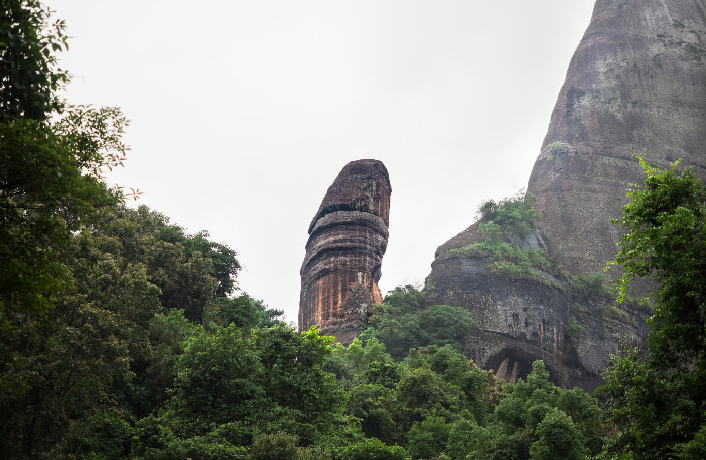
Image by Tristin Zhang/That’s
Situated in the northern Guangdong city of Shaoguan, this beguiling range of karst-like mountains boasts steep cliffs, lush trails and fresh, clean air. The stunning splendor of this red-tinged hikers’ paradise is so unique that it constitutes the sole UNESCO Natural Heritage Site in the southern province.
Though popular with visitors year-round, its massive size and numerous trails mean it’s rarely overwhelmed by crowds.
Upon arriving at the gate of the scenic area, you’ll likely be approached by scalpers offering discounted tickets for entry. Full-price tickets sell for RMB150 at the ticket office and grant you passage to both of the geopark’s main scenic areas.
En route to the peak, hikers pass through a Buddhist temple, calligraphic inscriptions etched into massive, multicolored cliffs and can detour to visit a historic Taoist shrine. On your descent, be sure to stop off at the famed Yinyuan Stone, a natural rock formation that bears a striking resemblance to an enormous human vulva.
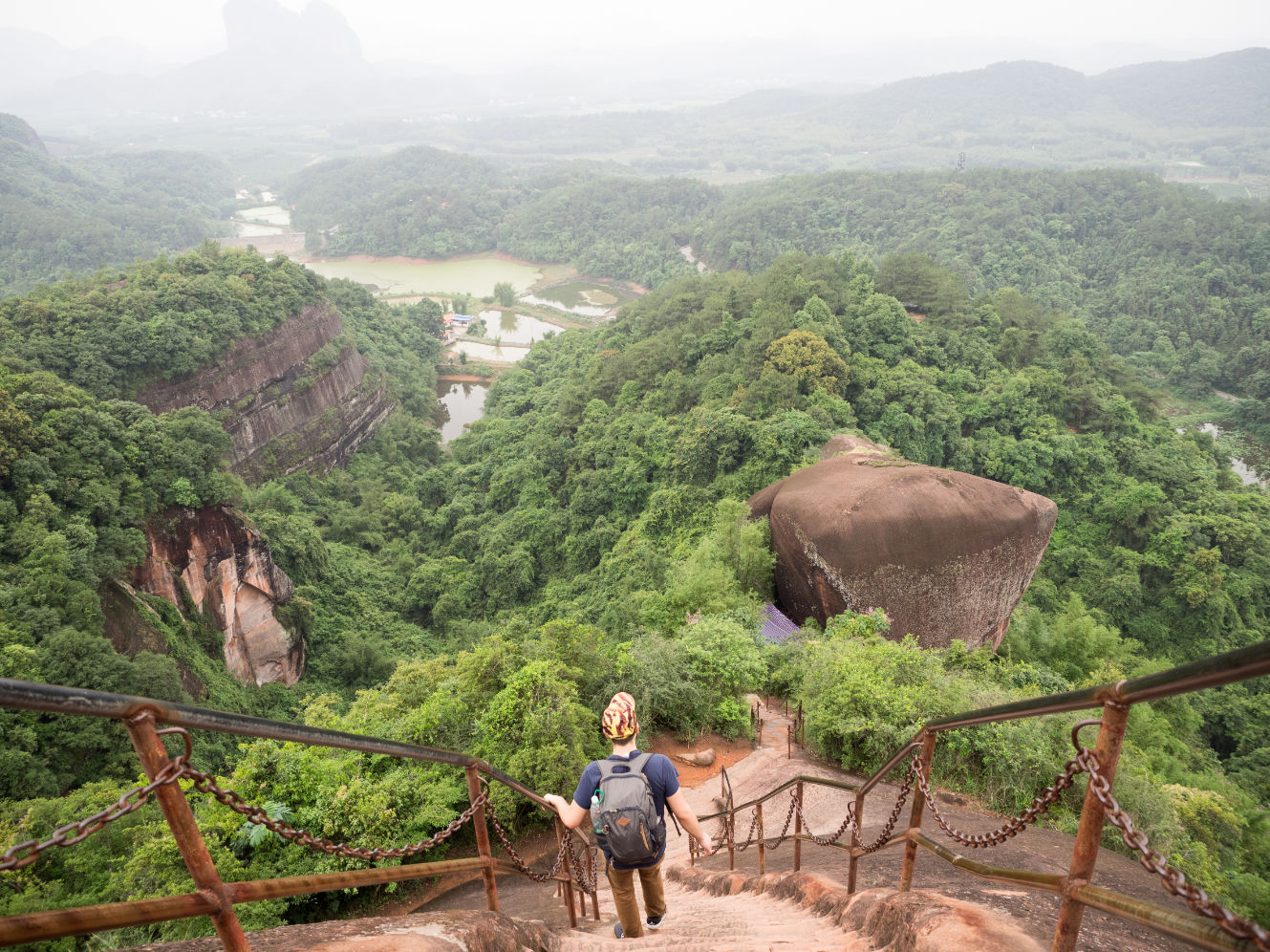
Image by Tristin Zhang/That’s
The main draw here is the Yangyuan Stone, a soaring column of phallic rock bearing an indisputable likeness to an erect penis. Ximei Fortress crowns the peak: a crumbling Ming Dynasty redoubt built by a despotic feudal tyrant from a nearby village that serves as an ideal place to admire a rosy sunset and enjoy a well-earned rest.
How to get there:
Take a one-hour fast train (RMB105) at Guangzhou South Railway Station to Shaoguan Railway Station. From there, take a shuttle bus (RMB21) to Danxiashan (丹霞山).
Recommended accommodation:
Forget hotels, this natural landscape demands camping! Rough it for a night or two by pitching a tent in the renowned scenic area. Alternatively, there’re plenty of guesthouses in the scenic area.
9. Zhuhai’s Miaowan Island
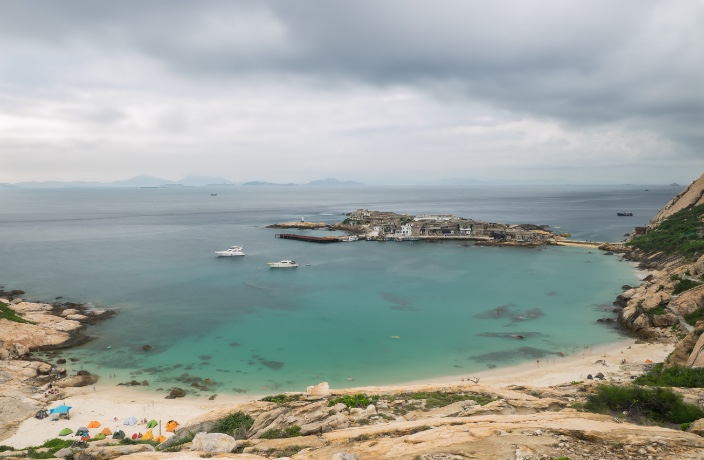
Image by Tristin Zhang/That’s
Take a one-hour fast train from Guangzhou, followed by an hour-long, swaying ferry ride and another heart-pounding hour on a speed boat and you’ll find yourself on the scenic island of Miaowan, which translates roughly to ‘temple bay.’
Resting to the southeast of Macau, and about 25 nautical miles from Hong Kong, Miaowan Island is a small plot of land in the South China Sea that is renowned for its pristine beaches and azure water. Under the administrative control of Zhuhai (a city rightly known as the ‘city with a hundred islands’), the island has attracted mainlanders over the past decade looking to escape the craziness of urban life for a secluded retreat. Deserved or not, Miaowan’s plentiful natural resources have earned it the moniker ‘China’s Maldives.’
There to capitalize on the island’s marine goodies is a small population of Cantonese-speaking fisherman (roughly two dozen households). Small businesses are run by the local population in Maiowan Village, which sits on a rock outcrop that is connected to the main island via a concrete bridge. Amid the barking of dogs and the whistle of seagulls, villagers set up their metal-mesh fish traps, using a mixture of bread, shrimp and fish, on the quay.
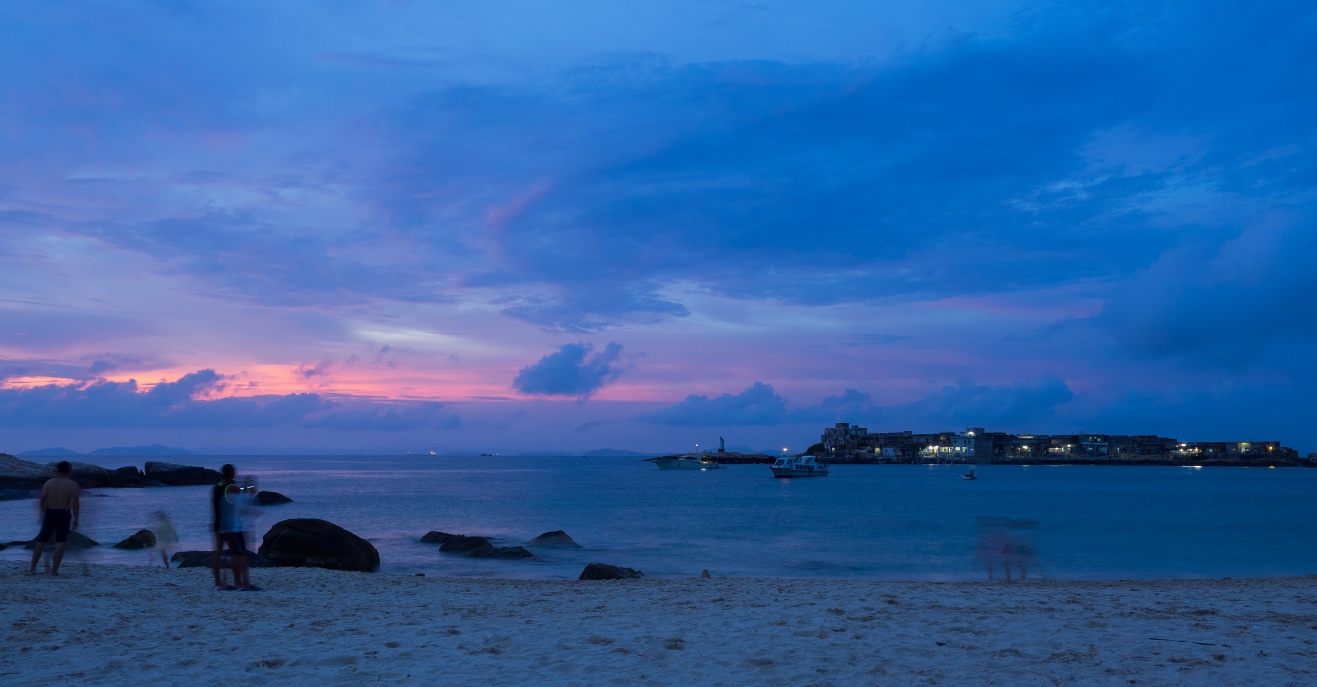
Image by Tristin Zhang/That’s
Fishing is allowed on Miaowan Island and the coral reefs off the coast are home to an array of tropical fish species. If you don’t have cooking equipment to cook your catch, restaurants run by hospitable islanders will prepare your seafood for a reasonable price.
Scuba diving courses are available and are run by a licensed dive instructor who moonlights as a server at a local restaurant.
Paying RMB100-200 for a meal at one of the island’s eateries may seem steep, but it’s worth noting that some of South China’s freshest and cleanest seafood is served here – and it’s well worth a sample.
How to get there:
Take a fast train from Guangzhou South to Zhuhai Station. Once you arrive in Zhuhai, you’ll need to take a ferry from Xiangzhou Port or Hengqin Port to Dongao Island, from which you’ll transfer to a speed boat for the remaining leg of the journey to Miaowan.
*Book a two-day trip through a private agent (about RMB500) to Miaowan Island in advance on zh-piao.com (0756-860 9991).
Recommended accommodation:
Camping on the beach! In addition to food, restaurants on the island also rent out tents at RMB150 per night. Hostels with air con-equipped rooms range from RMB200-300, though electricity is only generated at night and a cool, fresh water shower will cost you an additional RMB10.
10. Mount Luofu in Huizhou
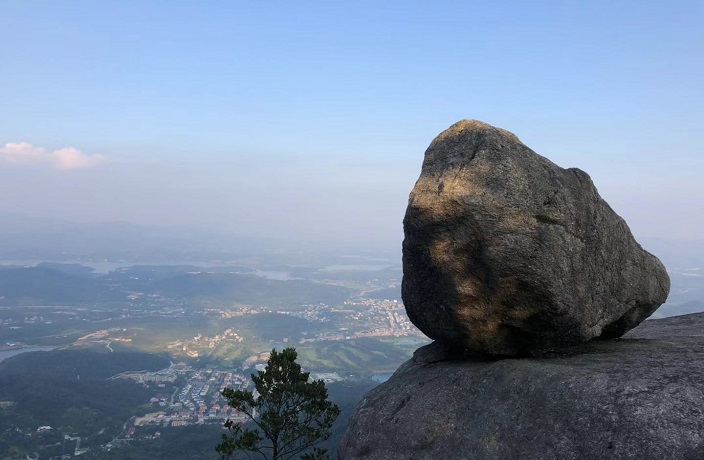
Image by Jonathan Zhong/That’s
Mount Luofu, located in the northwestern part of Huizhou’s Boluo county, dwarfs the Pearl River Delta region’s other famous peaks. With an elevation of 1,296 meters, Mount Luofu’s crown is 869 meters higher than the top of Baiyun Mountain in Guangzhou, and 950 meters higher than Mount Xiqiao in Foshan. In addition to dizzying heights, the scenic area Mount Luofu is set within claims 980 waterfalls and another 430 peaks.
While you can utilize a shuttle bus service or cable cars to travel part of the way up Mount Luofu (approximately 600 meters above sea level), the journey to the summit is one that must ultimately be traversed on foot.
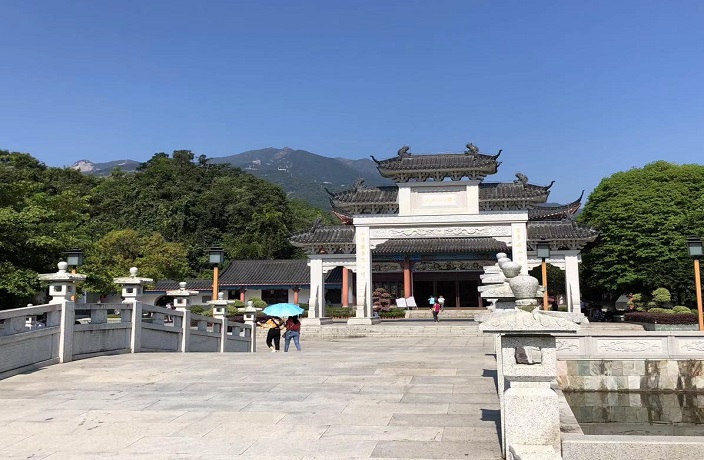
Image by Jonathan Zhong/That’s
The scenery on the lower portion of the mountain has little to write home about, but the upper half of 1,296-meter peak offers intrepid visitors phenomenal views and some unique rock formations to gawk at. It takes around five hours to walk to the top of the mountain, but it’s worth it. If you find yourself exhausted on the walk down, opt for the shuttle service or cable car to shorten the return journey.
To get the most out of your visit to Mount Luofu National Scenic Area, be sure to arrive early in the morning (8 or 9am) so that you’ll have plenty of time to wander the park and climb the mountain before the last cable car leaves at 5.30pm. We also strongly recommend bringing cash with you for this adventure, as phone reception in the park is nonexistent.
How to get there:
Take a bus from Tianhe Coach Terminal to Luofu Mountain (Boluo county/RMB40). Or, take a train from Guangzhou East Railway Station to Huizhou Railway Station (not Huizhou South Railway Station). From there, take a cab or bus (208, 209, 5, or 11) to Huizhou Coach Terminal, where you can catch a shuttle bus to the scenic area.
Recommended accommodation:
Once a mountain retreat that accommodated military officials, Luofu Mountain Yulan Hotel is a lakeside establishment in the scenic area, with classy decor and high-standard facilities. It boasts nine orange jessamine trees, which blossom from June to September and fill the air on the premises with fragrance.
11. Weizhou Island in Guangxi
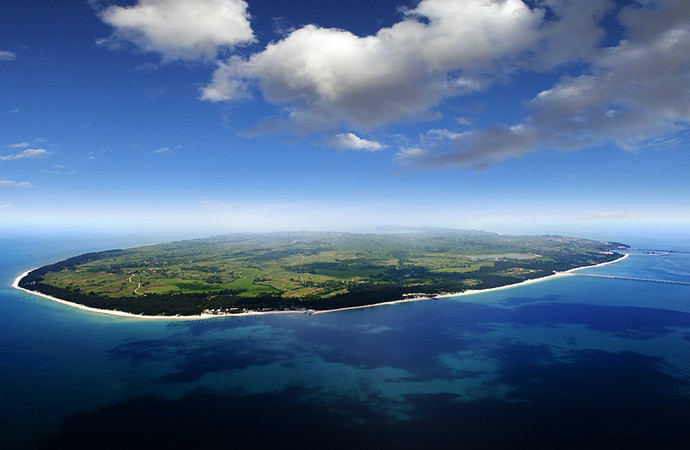
Image via Mafengwo
To the south of Beihai and east of Vietnam lies the volcanic island of Weizhou. Reputedly the youngest island of its type in China, it boasts a unique volcanic landscape and is home to a diverse collection of bird species. On the island you can visit Eryushan National Geopark, which showcases a beautiful array of volcanic rock, coral and sea creatures, among other exhibits.
Another popular spot, for both amateur and professional photographers alike, is ‘five color’ beach, which beckons tourists with its aesthetically pleasing rock formations that hug the shoreline. On the west of the island, visitors can catch one of China’s most sublime sunsets. Before leaving, be sure to pay a visit to one of Weizhou’s historic landmarks: Shengtang Catholic Church, which was built by French worshippers in the mid-1800s.
If you don’t like seafood, Weizhou probably isn’t your dream destination. Here, seafood items, most notably sea cucumbers and giant prawns, are available throughout the year and are a mainstay at restaurants and hotels across the island.
To get in on the action, we recommend checking out the South Bay seafood market, where you can peruse the daily catch and purchase fish or crustaceans to cook up yourself. Prices vary, and are dependent on the ‘rarity’ of the aquatic item that catches your eye.
If cooking while on vacation isn’t your thing, cheap seafood barbecue joints can be found after dark near the seafood market, or at Shiluokou.
How to get there:
Take a fast train from Guangzhou South Railway Station to Beihai Station (RMB226, second class; RMB362, first class). Riding the ferry to the island costs between RMB120-180, while entrance tickets are priced at RMB110.
Recommended accommodation:
For those looking to fully embrace the island vibes, we recommend setting up shop at one of the island’s few hostels. Otherwise, chill out on the mainland at Beihai Aegean Sea Resort Hotel. As with elsewhere in China, be sure that you book in advance if you’re planning on coming during the holidays, as the island is a popular tourist destination during the high season.
12. Yangjiang
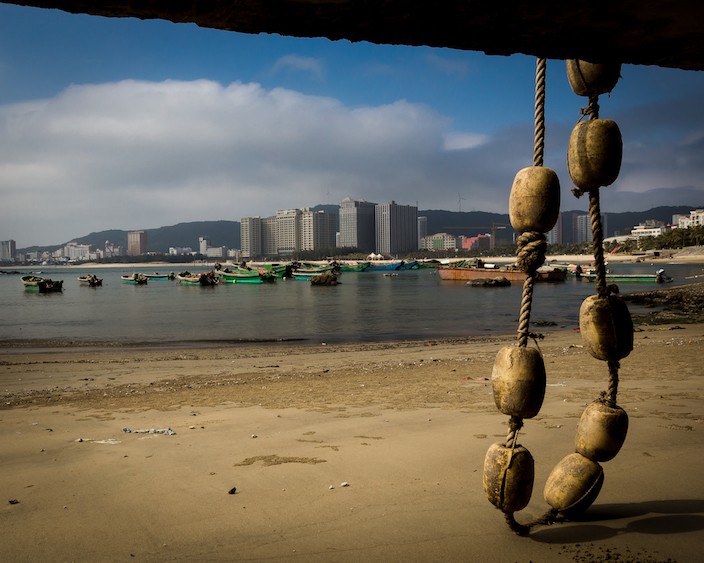
Image via Andy Barraclough
Like most small cities in China, Yangjiang is a place of stark contrasts. Located in southwestern Guangdong, the prefecture-level city is steeped in old culture, with a large, aging population and a number of urban farms and urban villages. In the vicinity of these older structures are new, scaffolded buildings climbing upwards at a fast pace.
On Yangjiang’s Hailing Island, this bipolar state of existence is also noticeable: While stunningly beautiful, the island’s raging tourism industry and numerous fishing businesses also render it tragically dirty.
While the city is at points beset by litter, it also has its moments of scenic serenity, given its geographical location on the long diagonal coastline that stretches from Guangzhou down to Zhanjiang.
Most tourists visit two distinct areas of the city: Yangjiang’s urban area, where the city’s high-speed railway station is located, and Hailing Island, the region’s main attraction, which is located to the southwest of the city.
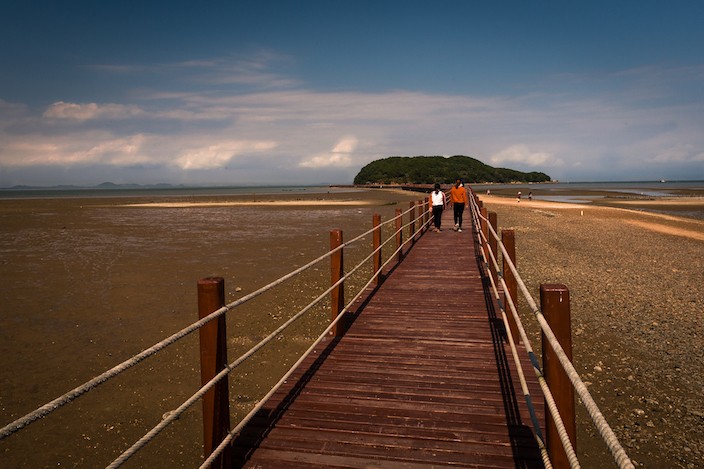
Image via Andy Barraclough
One of the more redeeming features of Yangjiang are the city’s beautiful waterways, with a network of rivers winding through the city to Beijin Harbor. When visiting the area, take the opportunity to learn about the local economy by visiting the National Maritime Silk Road Museum on Hailing Island. From the museum, you can easily reach Mawei Island, where you can gaze out over the ocean and gape at the plethora of fishing boats that dot the water’s surface.
On the western tip of Hailing Island, ATV rentals are available and visitors can race up and down the beach. On our visit, the cost of an ATV rental was set at RMB100 for 30 minutes. If you are more attuned to water sports, hitch a ride on a jet ski with a local driver for RMB150 per three turns around the small bay.
As a coastal city, Yangjiang is famed for its piscatorial delights. Crabs, shrimp, crawfish and many other aquatic treats are available at the numerous outdoor barbecues and seafood restaurants along the coast.
How to get there:
High-speed trains go daily from both Guangzhou South Railway Station and Shenzhen North Railway Station to Yangjiang Station.
Recommended accommodation:
There is an abundance of cheap, Chinese-style hotels that dot the area and, while nothing special, they do the job. We recommend staying on Hailing Island, but be sure to call ahead to check that your hotel of choice accepts foreigners. And, like everywhere else in China, make sure that you book in advance if you’re planning on coming during the holidays, as the city is a popular tourist destination during the high season.
With files from Matthew Bossons, Bryan Grogan, Tom Lee, Jocelyn Richards, Ziyi Yuan, Tristin Zhang, Jonathan Zhong
[Cover image by Matthew Bossons/That’s]
This article was originally published in August 2017. It has been updated and republished on January 21, 2020.
For more local travel ideas, check out our Daytripper series.





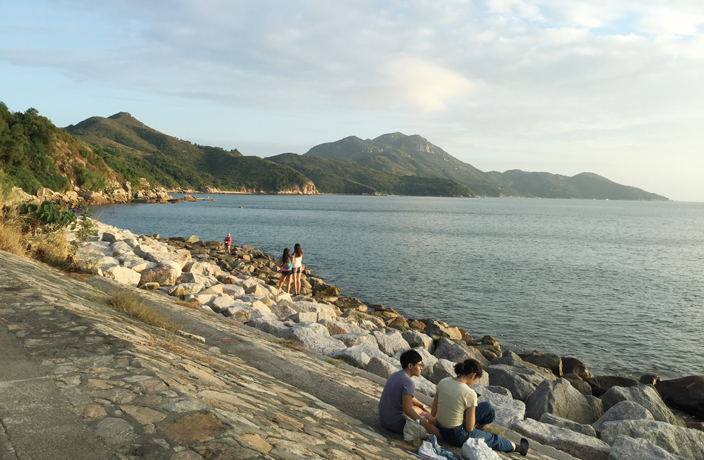
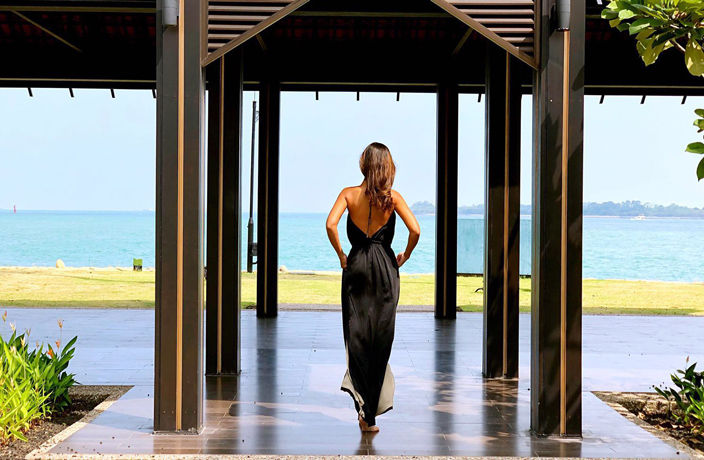
















0 User Comments